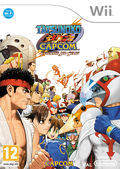You can trust VideoGamer. Our team of gaming experts spend hours testing and reviewing the latest games, to ensure you're reading the most comprehensive guide possible. Rest assured, all imagery and advice is unique and original. Check out how we test and review games here
Fighting games are back in vogue. With the incredible success of Street Fighter IV still ringing in our ears, the genre that was king in the early 90s has reclaimed its crown. 2009 will see the release of King of Fighters XII, Tekken 6, Marvel vs. Capcom 2 and, hopefully, Tatsunoko vs. Capcom: Ultimate All Stars.
Hold on…. what vs. Capcom? I said Tatsunoko. What? Tatsunoko. Eh? I SAID TATSUNOKO! Oh right. What’s that then?
Sigh. I shouldn’t be surprised. On these shores Tatsunoko means about as much to people as the Georgian Eurovision Song Contest entrant, but in Japan, it’s the shiz. It’s an anime production company of huge reputation – most Japanese have grown up loving its superhero-fuelled, Power Rangers-esque television shows in one form or another. Brand Tatsunoko is big business, which makes it perfect for the Capcom vs. treatment.
So, it signed up Bloody Roar developer Eighting for development duties and released Tatsunoko vs. Capcom: Cross Generation of Heroes in Japanese arcades and on the Wii in December. Included from the Capcom side were Ryu and Chun-Li (from Street Fighter), Viewtiful Joe (from Viewtiful Joe) PTX-40A (the giant robot from Lost Planet: Extreme Condition) and Roll (from Mega Man), among others. From Tatsunoko came Ken the Eagle and Jun the Swan (from Gatchaman), and Yatterman-1 and Doronjo (from Yatterman), again among others. Obscure isn’t strong enough a word.
Still, the coming together of Tatsunoko and Capcom proved irresistible to Japanese gamers. I remember seeing and hearing the game blasted from countless Tokyo game store televisions when I visited the city in November last year. Crowds gathered around to see the game pre-release, obsessing over its character roster and hyperactive combat. Here, I thought, was a fighting game worth further investigation. Here, I thought, was a fighting game that’s going to be big.
It wasn’t until last week, however, some eight months after the event, that I finally got to sit down and play the game. Capcom understandably itched its beard over whether it would bring the game to the west – not only were there complicated licensing issues to iron out, but resources would be required for localisation. Would it be worth it? After all, who cares about Tatsunoko?
Thankfully, Capcom’s decided it is worth it. I say thankfully because I’ve played it and had an absolute blast doing so. So much so that it’s stealthily climbed up my most anticipated Wii game list and perched itself next to Capcom’s own Resident Evil: The Darkside Chronicles and Team Ninja’s Metroid: Other M.
So, what’s it like? Anyone looking for a Street Fighter IV clone on Wii will be sorely disappointed – it’s nothing like that game. It’s more like Marvel vs. Capcom, actually, in that it’s a cross-over title (Capcom’s seventh), has a cartooney but eye-catching art style, and allows you to pick more than one character for a single fight (teams of two). But really the comparison is apt because of the similarities between both games’ fighting engines. The action is thick and fast, with super jumping, double jumping, dashing and air dashing meaning the characters speed about all over the place – up as well as left and right. Basic moves are easily strung together into combos and special moves are easily worked onto the end of combos. Forgiving is an appropriate word – TvC is designed to be more accessible than Street Fighter IV. Mashing buttons with quarter circle forward motions is likely to make you look like some kind of fighting game god.
Only four buttons are used – “Assist”, “Weak”, “Medium” and “Strong”. You pick two characters, which you’re able to swap between during a match by pressing the assist button (call your partner in for an attack) or by pressing back and the assist button (switches character and attacks). Tatsunoko’s Gold Lightan and Capcom’s PTX-40A, both huge, screen-filling characters, are forced to play on their lonesome, but everyone else is good for a pal. There’s a veritable smorgasbord of moves you can do that involve linking up with your partner: “Variable Assists”, “Variable Attacks”, “Variable Counterattacks”, “Snapbacks”, “Hyper Variable Combinations”, “‘Delayed Hyper Cancellations”, “Aerial Raves”, “Variable Aerial Raves”… there’s a lot. Still, it means the game’s got depth and that perfect easy to play, hard to master feel.
For my hands-on (with a lovely Capcom Wii fighting game stick) I picked Ryu, because, well, I know him, and, on the Tatsunoko side, Ken the Eagle, since he’s the brand poster boy and his move set is similar to that of Wolverine from Marvel vs. Capcom. My first fight was against none other than the producer of the game, Ryota Niitsuma. Ryu works as he does in all the vs. games – big hit combos are a breeze – Hadoukens and Shoryukens are easily strung onto the end of basic combos. With the super meter at least a level full (there are three), you’re able to string supers – screen-shattering moves that can bring the combo count spiralling toward the 50s – onto the end of combos, too. With a carefully-timed press of the assist button you can bring in your partner for their super as well. TvC’s supers are wonderfully satisfying, and are so spectacular that you fear they might make your eyes bleed if you don’t squint.
Clearly the focus in Tatsunoko vs. Capcom is on combos. Big combos. And the engine is designed so that you can set them up almost at will. The Aerial Rave Launcher – down forward and strong – knocks your opponent into the air. From there it’s combo time. You can even jump after your opponent by pressing up after the launcher, then go for an aerial combo. You can also string the launcher onto the end of combos – I was able, with Ryu, to do a basic weak, medium, launcher combo, pursue, then do a weak, medium, strong combo in the air. Simple, but effective.
Pretty much every character in the game can combo you off of a “Mega Crash” if they do it to you while you’re in the corner. The Mega Crash is a defensive manoeuvre that frees the character from the opponent while sacrificing a part of his or her life and two stocks of levels. What this means is that forcing and then keeping your opponent in the corner is a hugely important strategy, and is why you see a lot of players push their opponent as far as they can to the edge of the arena before rounds begin.
I somehow managed to beat Niitsuma-san at his own game (literally, hah!), but I’m sure he let me, the poor journalist, win. Much more satisfying was beating Capcom UK’s very own Leo Tan – I know he tried. But then Capcom’s translator beat me, using the cheap as hell Roll – a female housekeeping robot. She can heal (sigh), and uses a broom and bucket to attack. Bonkers.
Still, 2-1 versus Capcom is a great result, so great that I retired triumphantly. Even though my hands-on was brief, I’ve played enough to know the game’s great (it’s a Capcom fighter after all), and will no doubt be the best fighting game on the Wii. Wii owners might never see Street Fighter IV released on their console. Tatsunoko vs. Capcom is a worthy substitute.
Tatsunoko vs. Capcom is due out exclusively for the Wii. It is still without a European release date.

/https://oimg.videogamer.com/images/c32d/tvc_15.jpg)
/https://oimg.videogamer.com/images/1fc6/tvc_14.jpg)
/https://oimg.videogamer.com/images/65d8/tvc_13.jpg)






